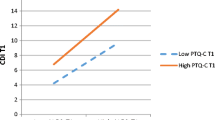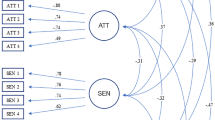Abstract
This longitudinal study examined the continuity of temperamental difficulty among a school-based sample of middle adolescents (n=975) over a one-year period. Of the participants, 25% were classified as difficult at one or both measurement occasions and over 40% were classified as temperamentally discontinuous. Repeated measures multivariate analyses of covariance analyses identified mean differences in psychosocial functioning by temperamental continuity groups and by gender. Temperamental difficulty was associated with higher levels of depression, stressful life events, use of some substances, and lower levels of perceived family support. Gender differences were indicated for family support, depression, life events, and alcohol use.
Similar content being viewed by others
References
Bates, J. E. (1987). Temperament in infancy. In Osofsky, J. D. (ed.),Handbook of Infant Development (2nd ed.). Wiley, New York.
Bates, J. E. (1989a). Concepts and measures of temperament. In Kohnstamm, G. A., Bates, J. E., and Rothbart, M. K. (eds.),Temperament In Childhood. Wiley & Sons, New York.
Bates, J. E. (1989b). Applications of temperament concepts. In Kohnstamm, G. A., Bates, J. E., and Rothbart, M. K. (eds.),Temperament in Childhood. Wiley, New York.
Bates, J. E., and Bayles, K. (1984). Objective and subjective components in mothers' perceptions of their children from age 6 months to 3 years.Merrill-Palmer Quart. 30: 111–130.
Buss, A. H. (1988).Personality: Evolutionary Heritage and Human Distinctiveness. Erlbaum, Hillsdale, New Jersey.
Chess, S., and Thomas, A. (1984).The Origins and Evolution of Behavioral Disorders. Brunner/Mazel, New York.
Chess, S., and Thomas, A. (1990). Continuities and discontinuities in temperament. In Robins, L., and Rutter, M. (eds.),Straight and Devious Pathways from Childhood to Adulthood. Cambridge University Press, New York.
Cohen, J. (1988).Statistical Power Analysis for the Behavioral Sciences (2nd ed.). Erlbaum, Hillsdale, New Jersey.
Crockenberg, S. B. (1986). Are temperamental differences in babies associated with predictable differences in care giving? In Lerner, J. V., and Lerner, R. M. (eds.),Temperament and Social Interaction During Infancy and Childhood, No. 31. New Directions for Child Development. Jossey-Bass, San Francisco.
Csikszentmihalyi, M., and Larson, R. (1984).Being Adolescent. Basic Books, New York.
Forman, B. D., Edison, K., and Hagan, B. J. (1983). Measuring perceived stress in adolescents: A cross-validation.Adolescence 18: 573–576.
Hagekull, B. (1989). Longitudinal stability of temperament within a behavioral style framework. In Kohnstamm, G. A., Bates, J. E., and Rothbart, M. K. (eds.),Temperament in Childhood. Wiley, New York.
Horwitz, A. V., and White, H. R. (1987). Gender role orientation and styles of pathology among adolescents.Journal of Health and Social Behavior 28: 158–170.
Ishiyama, F. I., and Chasbassol, D. J. (1985). Adolescents' fear of social consequences of academic success as a function of age and sex.Journal of Youth and Adolescence 14: 37–46.
Jessor, R., Graves, R., Hansen, R., and Jessor, S. (1968).Society, Personality, and Deviant Behavior. Holt, New York.
Kandel, D. B., & Davies, M. (1986). Adult sequelae of adolescent depressive symptoms.Archives of General Psychiatry 43: 255–265.
Korn, S. J. (1984). Continuities and discontinuities in difficult/easy temperament: Infancy to young adulthood.Merrill-Palmer Quart. 30: 189–199.
Lerner, J. V., and Vicary, J. R. (1984). Difficult temperament and drug use: Analyses from the New York Longitudinal Study.J. Drug Educat. 14: 1–8.
Luby, J. L., and Steiner, H. (1993). Concordance of parent-child temperament ratings in a clinical sample of adolescent girls.Child Psychiatr. Human Develop. 23: 297–305.
Matheny, A. P., Wilson, R. S., and Nuss, S. M. (1984). Toddler temperament: Stability across settings and over ages.Child Develop. 55: 1200–1211.
Maziade, M. (1989a). Child temperament as an epidemiological concept. In Carey, W. B., and McDevitt, S. C. (eds.),Clinical and Educational Applications of Temperament Research. Swets & Zeitlinger, Amsterdam.
Maziade, M. (1989b). Should adverse temperament matter to the clinician? An empirically based answer. In Kohnstamm, G. A., Bates, J. E., and Rothbart, M. K. (eds.),Temperament in Childhood. John Wiley, New York.
Maziade, M., Caron, C., Côté, R., Boutin, P., and Thivierge, J. (1990a). Extreme temperament and diagnosis: A study in a psychiatric sample of consecutive children.Arch. Gen. Psychiat. 47: 477–484.
Maziade, M., Caron, C., Côté, R., Merette, C., Bernier, H., Laplante, B., Boutin, P., and Thivierge, J. (1990b). Psychiatric status of adolescents who had extreme temperament at age 7.Am. J. Psychiat. 147: 1531–1536.
Maziade, M., Côté, R., and Thivierge, J. (1989). Significance of extreme temperament in infancy for clinical status in preschool years, I: Value of extreme temperament at 4–8 months for predicting diagnosis at 4.7 years.Br. J. Psychiat. 154: 535–543.
McDevitt, S. C., and Carey, W. B. (1981). Stability of ratings vs. perceptions of temperament from early infancy to 1–3 years.Am. J. Orthopsychiat. 51: 342–345.
Procidano, M. E., and Heller, K. (1983). Measures of perceived social support from friends and from family: Three validation studies.Am. J. Commun. Psychol. 11: 1–24.
Radloff, L. S. (1977). The CES-D scale: A self-report depression scale for research in the general population.Appl. Psychol. Measure. 1: 385–401.
Rothbart, M. K. (1986). Longitudinal observation of infant temperament.Child Develop. 52: 569–578.
Rothbart, M. K., and Goldsmith, H. H. (1985). Three approaches to the study of infant temperament.Develop. Rev. 5: 237–260.
Rutter, M. (1986). The developmental psychopathology of depression: Issues and perspectives. In Rutter, M., Izard, C. E., and Read, P. B. (eds.),Depression in Young People. Guilford Press, New York.
Rutter, M. (1987). Temperament, personality, and personality disorder.Br. J. Psychiat. 150: 443–458.
Stapley, J., and Haviland, J. M. (1989). Beyond depression: Gender differences in normal adolescents' emotional experiences.Sex Roles 20: 295–308.
Thomas, A., and Chess, S. (1977).Temperament and Development. Brunner/Mazel, New York.
Thomas, A., and Chess, S. (1989). Temperament and personality. In Kohnstamm, G. A., Bates, J. E., and Rothbart, M. K. (eds.),Temperament in Childhood. Wiley, New York.
Thomas, A., Chess, S., and Birch, H. G. (1968).Temperament and Behavior Disorders in Children. New York University Press, New York.
Thomas, A., Chess, S., Birch, H. G., Hertzig, M. E., and Korn, S. (1963).Behavioral Individuality in Early Childhood. New York University Press, New York.
Thomas, A., Chess, S., and Korn, S. J. (1982). The reality of difficult temperament.Merrill-Palmer Quart. 28: 1–20.
Thomas, A., Chess, S., Lerner, R. M., and Lerner, J. V. (1989).Behavioral Individuality in Adult Life. Final report to the National Institute of Mental Health (Grant No. MH39957).
Tubman, J. G., Lerner, R. M., Lerner, J. V., and von Eye, A. (1992). Temperament and adjustment in young adulthood: A 15-year longitudinal analysis.Am. J. Orthopsychiat. 62: 564–574.
Weissman, M. M., Sholomskas, D., Pottenger, M., Prusoff, B. A., and Locke, B. Z. (1977). Assessing depressive symptoms in five psychiatric populations: A validation study.Am. J. Epidemiol. 106: 203–214.
Windle, M. (1987). Stressful life events, general mental health, and temperament among late adolescent females.J. Adoles. Res. 2: 13–31.
Windle, M. (1988). Psychometric strategies of measures of temperament: A methodological critique.Int. J. Behav. Develop. 11: 171–201.
Windle, M. (1991). The difficult temperament in adolescence: Associations with substance use, family support, and problem behaviors.J. Clin. Psychol. 47: 310–315.
Windle, M. (1992a). Temperament and social support in adolescence: Interrelations with depressive symptoms and delinquent behaviors.J. Youth Adolesc. 21: 1–21.
Windle, M. (1992b). Revised Dimensions of Temperament Survey (DOTS-R): Simultaneous group confirmatory factor analysis for adolescent gender groups.Psychol. Assess. 4: 228–234.
Windle, M., Hooker, K., Lenerz, K., East, P. L., Lerner, J. V., and Lerner, R. M. (1986). Temperament, perceived competence, and depression in early- and late-adolescents.Develop. Psychol. 22: 384–392.
Windle, M., and Lerner, R. M. (1986). Reassessing the dimensions of temperamental individuality across the life span: The Revised Dimensions of Temperament Survey (DOTS-R).J. Adoles. Res. 1: 213–230.
Windle, M., and Miller-Tutzauer, C. (1992). Confirmatory factor analysis and concurrent validity of the Perceived Social Support-Family Measure among adolescents.J. Marriage Family 54: 777–787.
Yeaworth, R. C., York, J., Hussey, M. A., Ingle, M. E., and Goodwin, T. (1980). The development of an adolescent life change event scale.Adolescence 15: 91–97.
Youniss, J., and Smollar, J. (1986).Adolescent Relations with Mothers, Fathers, and Friends. University of Chicago Press, Chicago.
Author information
Authors and Affiliations
Additional information
This research was supported in part by NIAAA Grant No. AA07861 awarded to Michael Windle.
Received Ph.D. in human development and family studies from the Pennsylvania State University. Major research interests involve individual and family contextual influences on the etiology and development of internalizing and externalizing behaviors in childhood and adolescence.
Received Ph.D. in human development and family studies from the Pennsylvania State University. Major research interests involve the identification of high-risk factors for adolescent substance use and other problem behaviors.
Rights and permissions
About this article
Cite this article
Tubman, J.G., Windle, M. Continuity of difficult temperament in adolescence: Relations with depression, life events, family support, and substance use across a one-year period. J Youth Adolescence 24, 133–153 (1995). https://doi.org/10.1007/BF01537146
Received:
Accepted:
Issue Date:
DOI: https://doi.org/10.1007/BF01537146




